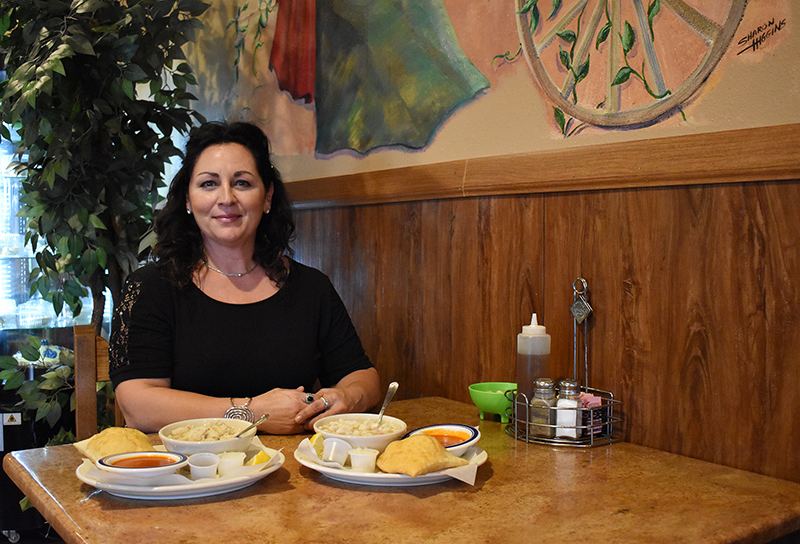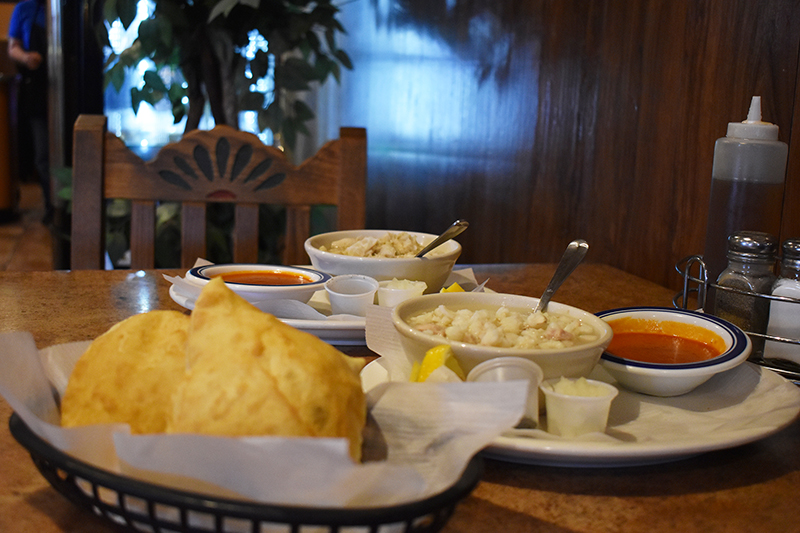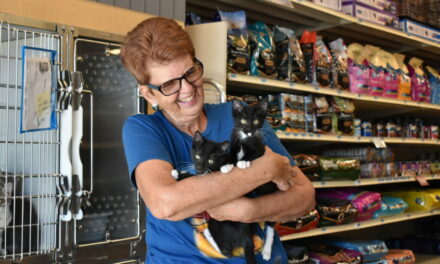The traditions that feed us

Makayla Grijalva | News-Bulletin photo
Vanessa Gonzales, one of the owners of Sopa’s Restaurant in Bosque Farms, says all of the recipes served at the restaurant, including for menudo and posole, are traditional the way she and her sisters grew up eating them.
Whether during Christmas, Thanksgiving or on the weekends at a favorite local restaurant, both posole and menudo continue to be traditional New Mexican favorites, no matter how they are enjoyed.
At Sopa’s Restaurant in Bosque Farms, owner Vanessa Gonzales said they made the decision to serve both menudo and posole without chile to honor her father, who enjoyed the dish typically without it.
“Some people don’t like it,” Gonzales said. “I know my dad, in particular, his first bowl of posole is always with no chile.
“The second for Christmas — his next one will have a little chile in it. So, we don’t make it with any chile mixed in, and I know a lot of places do. They mix the red right into it.”
She notices a lot of people who order either posole or menudo and eat it just as it was served to them, just like her dad would — no chile.
However, her personal preference is to mix the two together and enjoy it with red chile. Green chile, of course, is also an option, though less preferred in Gonzales’ experience.
Gonzales, her two sisters and their mother opened Sopa’s in 2001, and since the beginning, posole has been a staple on their menu, with menudo added later.
“(The menu was inspired by) our own upbringing, my mom’s recipes — our grandma was also in the restaurant business,” Gonzales said. “We just wanted good New Mexican food, and growing up with good New Mexican food, that’s what we wanted to offer.”
When Sopa’s was perfecting their posole recipe, they wanted to ensure they had the hominy that popped, and was more round shaped rather than a flatter corn. They also serve it with oregano, onion and lemon on the side of the dish.
“In my experience, the New Mexican restaurants I’ve eaten at — I love their posole. I actually love the flat hominy, but they add the oregano automatically to the mix. We leave all of ours on the side,” Gonzales said. “They add the oregano, they add the chile, sometimes they add cabbage. It’s all delicious, but ours is just more plain. It’s traditional for us because that’s what we grew up having.”

According to reporting in the Albuquerque Journal, posole originated in Meso-America where corn was a staple crop which could be dried and therefore preserved. As food preservation evolved, the corn began being soaked in a wood ash and water mixture, which would keep the hominy fresh tasting for years to come.
With the arrival of the Spanish to New Mexico in the 1500s, pork became a regular staple of the dish. The ability to make posole in large quantities cemented the dish’s place on the table at large celebrations and gatherings, such as Christmas.
While Gonzales comes from a posole family herself, her dad’s mother — who also owned a restaurant in the Taos area — would make menudo during the holidays. It was her recipe which inspired the one served at Sopas today.
“It’s just a basic menudo recipe,” Gonzales said. “It’s just the cut of the tripe that you get. The quality of the tripe makes it good and makes it special, because not everyone can stomach menudo.”
Honeycomb tripe, the kind used by not only Sopa’s but many restaurants which serve menudo, is the edible lining in a cow’s second stomach. Gonzales said since many people are wary of the food, they make sure to clean theirs well using vinegar.
While both menudo and posole were first only served on the weekends at Sopa’s, demand grew justifying offering the favorite all week.
“We serve it all day, every day, all year,” she said. “I know, it’s kind of crazy for me because personally, I only eat posole for Christmas or New Year’s, but, there are people who come in and they order it every single time they come. They love it.”
Similar to most New Mexicans, for Esther Sharp of Belen, both menudo and posole were holiday meals made yearly by her mother. Although her parents met in California, her mother made it a point to make menudo every year since she was raised in and called Albuquerque home.
“When they adopted my brothers and I, they knew that they would have to make a tradition and eating menudo at Christmas time was a must,” Sharp said. “I grew up eating it, along with posole, but if I had to pick a favorite it would be menudo.”
Sharp still enjoys menudo every year around Christmas time — now also during Hanukkah — keeping with the traditions instilled by her mother when she was younger. While her husband was not a fan of menudo at first, he came around and is now the one to make it every year.
“Now with my mom gone — she died last June — he has caught on to her cooking style and has been making menudo. Our three kids love it just as much as we do,” Sharp said. “It makes us feel closer to her and knowing that she is still with us.
Makayla Grijalva was born and raised in Las Cruces. She is a 2020 graduate of The University of New Mexico, where she studied multimedia journalism, political science and history.
















